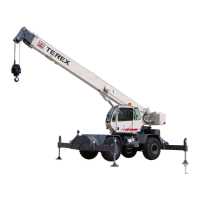OPERATOR AIDS CHECK
2. Boom angle indicator.
3. Travel Alarms.
4. Anti-Two block devices.
5. Overload prevention devices, load indicators and rated capacity limiters.
OPERATION OVERLOAD PREVENTION
1. Know the weight and characteristics of all loads to be lifted.
2. Place the boom lifting point directly above the load when lifting.
3. The load radius will increase when the load is lifted due to boom deflection.To
compensate for the boom deflection, maintain the radius by raising the boom.
4. Know the weight of the hook and rigging, the boom and/or jib length, parts of line and
the work area.
5. Use next lower rated capacity when working at boom lengths or radius between the
figures on the rated lifting capacity chart.
6. Never lift a load without knowing whether it is within the rated capacity.
7. Never operate with anything other than recommended counterweight.
Unauthorized reduction or additions of counterweight constitute a safety hazard.
8. Do not lift loads if winds create a hazard. Lower the boom if necessary. Refer to the
Rating Chart and Operator’s Manual for possible restrictions.
9. Avoid side loading the boom.
10. Never allow the load or any other object strike the boom.
11. Release the load slowly and ensure that the boom never tightens against boom stops.
12. Loads shall be freely suspended.
OPERATION SETUP
1. Be sure the load bearing surface is strong enough to support the machine and load.
2. Be sure the crane is level. Check frequently and re-level when necessary.
3. Stay away from rotating cranes, erect barricades to keep people away. Make sure
these areas are clear before swinging.
Safety
36 P/N 12261-319 REVISED: August 2012
Courtesy of Crane.Market

